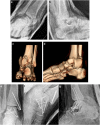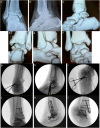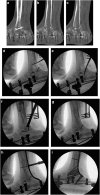Current Concepts in Talar Neck Fracture Management
- PMID: 29974334
- PMCID: PMC6105488
- DOI: 10.1007/s12178-018-9509-9
Current Concepts in Talar Neck Fracture Management
Abstract
Purpose of the review: Talar neck fractures are a rare but potentially devastating injury, which require a comprehensive understanding of the unique osteology, vasculature, and surrounding anatomy to recognize pathology and treat correctly. The purpose of this article is to describe both classic and current literature to better understand the evolution of talar neck fracture management.
Recent findings: Urgent reduction of displaced fractures and dislocations remains the standard of care to protect the soft tissue envelope and neurovascular structures. Delayed definitive fixation has proven to be safe. CT is the imaging modality of choice to fully identify the fracture pattern and associated injuries. Anatomic reduction and restoration of the peritalar articular surfaces are the pillars of talar neck fracture treatment. Dual incision approach with plate and screw fixation has become the modern surgical strategy of choice to accomplish these goals. Although complications such as osteonecrosis (ON) and posttraumatic arthritis (PTA) can still occur at high rates, treatment should be dictated by patient symptoms. Talar neck fractures pose treatment challenges with both initial injury and potential sequelae. Future research will determine whether modern treatment algorithms will decrease complication rate and improve patient outcome.
Keywords: Complications; Outcomes; Review; Talar neck fracture; Treatment.
Conflict of interest statement
Conflict of interest
The authors declare that they have no conflict of interest.
Human and animal rights and informed consent
This article does not contain any studies with human or animal subjects performed by any of the authors.
Figures










References
Publication types
LinkOut - more resources
Full Text Sources
Other Literature Sources
Research Materials
Miscellaneous

